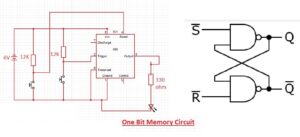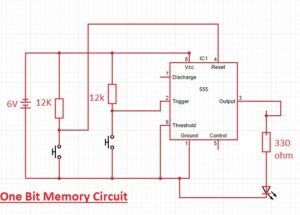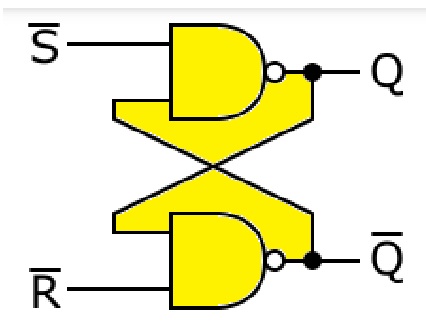 Hello, readers welcome to the new post. In this post, we will discuss One bit Memory Circuit. There are different types of memory cell circuits used for digital electronics that are implemented in various projects. Currently, other electronic devices and tools use internal and outer memories. Some modules use I2C EEPROM and flash memory units. These memory units are used to store data and different types of documents. Here we are going to make a one-bit memory circuit through a combination of NAND latch circuits that will help to store different data types in digital electronics. With that, we will get the project creation services from PCBWAY which is the best in all services.
Hello, readers welcome to the new post. In this post, we will discuss One bit Memory Circuit. There are different types of memory cell circuits used for digital electronics that are implemented in various projects. Currently, other electronic devices and tools use internal and outer memories. Some modules use I2C EEPROM and flash memory units. These memory units are used to store data and different types of documents. Here we are going to make a one-bit memory circuit through a combination of NAND latch circuits that will help to store different data types in digital electronics. With that, we will get the project creation services from PCBWAY which is the best in all services.
PCBWay is a Chinese PCB manufacturing company that produces more than 2100 PCBs distributed worldwide every day. They offer a wide range of PCB prototyping, assembly, design and CNC/3D printing services across five factories employing over 520 employees.
With investments in new equipment, quality control and user support, PCBWay provides superior service at very competitive prices. The company stands out for its support of a wide range of technologies and a user-friendly website, but above all for its strong community support.
PCBWay provides everything needed to complete electronic projects from start to finish, while more than 70 employees ensure defect-free quality assurance and on-time delivery. The company sources materials from well-known brands and maintains ISO 9001 and UL certifications to streamline its customers’ journey to commercial products.
The process of creating such products usually starts with PCB prototyping. As one of their most popular services, there is virtually no limit to the size, shape and complexity of the printed circuit boards the company can create, allowing you to fine tune the board parameters to include different base materials, thicknesses and a number of layers, screen printing colors, and solders. masks, finishes and so on.
The primary base materials that PCBWay works with include:
Solid Circuit Boards These high-tech, high-quality boards are based on HDI/Rogers/High-Tg technologies and are typically reserved for high-frequency electronics, automotive subsystems, and other demanding applications.
Aluminum printed circuit boards With two types of aluminum printed circuit boards – central and base core – PCBWay customers can choose between higher energy dissipation properties or higher mechanical stability of the material.
Copper printed circuit boards – the aluminum base can be replaced with copper for better thermal performance and other specific properties, but at a higher cost.
Flexible PCB Flex PCB can be used in smartphones, cameras and non-standard portable devices or miniature electronics. You can squeeze them into tight spaces, and bend and wrap them to remove the restrictions of the enclosure.
Rigid-Flex PCB This technology combines flexible and rigid printed circuit boards into a single unit without additional connections between them. It is easier and cheaper to manufacture while having the advantages of both technologies.
Their pricing structure is transparent and contains no hidden costs. Their price is one of the most competitive in the world and is a fraction of what other US or European manufacturers normally charge you. Even many price-sensitive customers such as students and hobbyists rely heavily on PCBWAY for their PCB prototype, low-volume production, and assembly needs. They strive to save you money and time.

What is One-bit memory cell
- The one-bit memory cell also called the basic bistable element that is digital circuitry has the ability to store one bit of information.
- It is a series of circuitry that has the ability to hold its state till another input is not received which results in a change of state.
- One-bit memory cells are used in digital circuits as temporary storage components and work as a building block of complicated sequence circuitry like flip-flop latches.
- There are two main types of One-Bit Memory Cells. SR or set reset flip flops and D flip flops.
- The SR flip flop is a category of the one-bit memory cell which has two inputs set and reset. The set input sets the output to 1 and resets input resets the output to zero. If both S and R are one flip flop has an undefined state
- The data flip-flop has two inputs D and a clock signal. The output of the flip flop is according to input at D pin till the clock signal is high. If the clock signal is the low output of the flip flop is stored and exists till the other rising edge of the clock signal.
- One-bit memory cells are used in different circuits of digital electronics like data storage, control circuits,, and state machines.
- As flip flop has the ability to store one bit through which we can store more bits by rising the number of flip flops so used in the type of memory cells. While for analog electronics circuitry and hobbyist circuits, there is four-bit and eight-bit memory cells that are an electronic lock.
- Different types of memory cells are used but here we will construct a one-bit memory unit through the use of a timer.
RS NAND Latch
- There are two logic NAND gates used for the creation of a one-bit memory unit.
- Here block diagram can see that has two inputs and two outputs. Here if we have logic zero at both inputs then the output will be the undefined state and if we give 1 at both inputs then there is no change in outputs.
- If the set pin is logic zero and R’ is 1 then output Q is 1 and Q’ is zero called set condition and this output not changes till the return of S’ to logic one or high
One bit Memory Project Circuit

- Here components used in this project are listed
- LED
- Capacitor
- Button
- Resistors
- Timer
- Power supply
- PCB from PCBWAY
One bit Memory Circuit and Working

- Here we have created the one-bit memory circuit through the use of a timer-integrated circuit. There are flip-flop circuits used here.
- The components of the circuits are 12-kilo ohm two resistance, one resistance 330 ohms, two push buttons used, and a battery of six volts applied. But you can use a voltage supply of six to twelve volts.
- The connection of reset input and trigger pins is made with the ground through the bush button. If we push the button then the ground supply flows to the resultant pinout.
- Threshold input is connected with ground and output pinout is configured with an LED that indicates the stored bit.
- If led illuminates light then there is one logic and if led not glow zero logic exists.
- If the set button is pushed to the logic bit one is stored in flip-lop internal circuitry. If the reset button is pushed logic zero bit is stored in the timer flip flop
Advantages of One Bit Memory Cells
- Here some advantages of the one-bit circuit are explained.
- The creation of a one-bit memory circuit has a simple digital circuit that needs some components to create circuits. This makes it less expensive and easy to construction
- There are different types of projects that can create through these circuits that make it flexible like data storage, control circuits and state machines
- Its operating speed is high that makes it good for high speed digital operations
- It uses less power consumption so it used for less power-consuming projects
One Bit Memory Cells Disadvantages
- There are some drawbacks of a one-bit memory unit explained here
- Its main disadvantage is that it stores single-bit information so not used for high storing applications
- It has less reliability and stability for sequential circuits and it provides the complicated operation
- If it uses more transistors for circuit creation then it becomes more costly than other projects
One Bit Memory Applications
- It has the ability to program-enable features for data storing and permits temporary storing of combination circuitry output that is used in digital systems.
- Sequential circuits are called logic circuits that are used for memory cells.
That is all about the bit Memory Project Circuit all details has explained. If you have any questions ask them here





